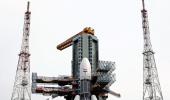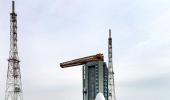
India's lunar mission will not only boost its science and technology but also help all space-faring nations to eventually set up man's permanent presence on the Moon, says former National Aeronautics Space Administration astronaut Jerry Linenger as the countdown for the Chandrayaan-2 spacecraft to land on the celestial body nears its end.
Indian Space Research Organisation's (ISRO) Chandrayaan-2 spacecraft is set to land on the Moon anytime between 1.30 am and 2.30 am on September 7 (Saturday).
"It's a fantastic mission, everybody should be so excited. And I'm going to be sitting on the edge of my seat. And it's a privilege for me to be here, lending some expertise to that live broadcast," Linenger told PTI in an e-mail interview.
Although Russia, United States and China have achieved a soft landing on the lunar surface, India is aiming at becoming the first one to explore the south pole of the Moon.
Linengar, who flew on Russian space station Mir that operated in low Earth orbit from 1986 to 2001 for five months, is in India to take part in the Chandrayaan-2 live telecast on the National Geographic Channel starting 11.30 pm on Friday.
"This mission is unique, it's heading towards the south pole of the Moon, about 70 degrees latitude south. And that's where we think there might be frozen water. And so for example, the US is hoping to put a manned mission to the Moon in 2024," Linenger said.
In order to do that, the US will probably pick a landing site that is close to water, the essence of life, the 64-year-old said.
"So this actually helps not only India and advancement of their science and their technology, it actually helps all space-faring nations on earth to advance, you know, our exploration to the Moon and to eventually set up a permanent presence of man on the moon, I should say, of people on the Moon," he said.
An astronaut narrator and space analyst, Linenger is impressed by the Indian space agency's low cost missions.
The Chandrayaan-2 mission cost Rs 978 crore, less than the budget of Hollywood blockbuster Avengers: Endgame.
"I think the world can learn from that, you know, the cheaper the missions get, the more missions we can launch and the more we learn, and the more mankind's knowledge advances," he said.
"On the other hand, the technology of it -- three different vehicles, you've got this orbiter going around about 100 kilometers up, using synthetic capture radar to sort of map that southern region in the Moon, and you've got a lander trying to soft land, that's always a difficult task.
"And then, you know, having a robot up there driving the rover out, and accomplishing that technology. And I'm excited about all three of them," said Linenger.
Known for surviving a fire in 1997 during one of the most dramatic missions in space history aboard an orbiting spacecraft, Linenger noted that NASA is also involved in the mission to some extent as the US space agency has asked to hitchhike a laser reflector on board the Chandrayaan mission.
"…hoping that India can put that laser reflector on the Moon, and then any other orbiting spacecraft around the Moon can ping off that laser and figure out exact altitude and that is very helpful," the astronaut said.
He said this will be helpful. Once the exact altitude is known, you can make more accurate measurements and depth and the size of the lunar craters, Linenger explained.
"And so US, for example, is benefiting from this mission directly. And then indirectly, again, the more nations that can have that capability to explore, the more we learn about that very big Moon out there," he said.
According to Leninger, exploring a different region of the Moon (south pole) is a major accomplishment which helps further our knowledge in a big way.
He noted that the entire world has its eyes glued on the mission and people involved should be proud.
"They are on the edge of their seats, just like the people in India are, I would hope. I travelled here because I'm excited, I'm ready to celebrate.
"And so I guess I would just put this caveat out there that getting to the Moon, having that lander separate from the orbiter is already a fantastic accomplishment that everybody in India should be proud of, and especially the people that were directly involved in making that all happen," he said.
Leninger was just 14 years old when, in 1969, the Apollo mission landed on Moon.
"I think the whole world was celebrating during that Moon landing back 50 years ago. And now little by little, with advanced technology that we have, we can go back to the Moon in a more significant way, set up a permanent presence of man or of human beings on the Moon," he said.
The Chandrayaan-2 mission was launched on July 22 by a Geosynchronous Satellite Launch Vehicle Mark III (GSLV Mk III).
The Chandrayaan-2 spacecraft began its journey towards the Moon, leaving the Earth's orbit, on August 14, after a crucial manoeuvre called Trans Lunar Insertion or TLI that was carried out by ISRO to place the spacecraft on 'lunar transfer trajectory'.










